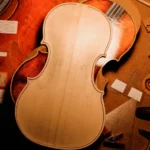Step-by-Step Guide: How to Change Strings on Violin, Viola, or Cello
Back to BlogHow to Change Strings on Violin, Viola, or Cello
Whether you’re a beginner or an experienced musician, knowing how to change strings on violin, viola, or cello is essential for maintaining sound quality and playability. Fresh strings bring out the best in your instrument and ensure it stays in optimal condition. This step-by-step guide covers removing old strings and tuning new ones for optimal performance.
Tools You’ll Need to Change Strings
Before getting started, it’s essential to have the necessary tools on hand:
- New strings: Always have a complete set of new strings ready. For string players, it’s wise to keep spares in your case.
- Soft Pencil: they are the key for a longer string durability and sound quality.
- Tuner: A tuner or tuning app is necessary to check the pitch as you install new strings.
- Soft cloth: Use a cloth to clean your instrument as you go, especially areas under the strings that are often hard to reach.
Step 1: Loosen and Remove the Old Strings
Begin by removing the old strings. Changing strings one at a time prevents stress on the instrument’s bridge or soundpost. Start with the A or E string, gently loosening the pegs and unwinding the string entirely. Carefully remove the string from the peg hole and unhook it from the fine tuner or tailpiece.
After removing the old string, inspect the peg to ensure the side of the hole is clean and debris-free. This preparation makes it easier to install the new string. Handling each string helps maintain the instrument’s alignment and prevents damage during the string replacement process.
Step 2: Prepare and Install the New String
After removing the old string, install the new one by placing the ball end into the tailpiece or fine-tuner. Insert the opposite end into the peg hole. Wind the string smoothly and avoid overlapping.
At this point, there’s something you can do to improve your instrument’s sound and the strings’ durability and response: use a soft pencil to make some signs and lubricate the bridge and over the nut just right where the strings lay. Now turn the pegs consistently until the string feels snug, but don’t over-tighten. Proper winding and installation ensure accurate tuning and maintain string stability.
Step 3: Tune the New String to Pitch
Now that you’ve installed the string bring it up to pitch. Use your tuner to check the correct note, and turn the pegs slowly to tighten the string. Be careful not to over-tighten, as new strings can break if tuned too quickly. New strings need time to settle, so they may not initially hold the pitch for long. Over the next few days, they will stretch and stabilize.
Step 4: Repeat the Process for Each String
Change each string one at a time, working methodically. Watch the bridge to keep it aligned and check overall tuning. The tension changes with each new string may affect the pitch of the installed strings, so adjust and tune regularly.
Step 5: Allow Time for the Strings to Settle
After installing all the strings, give them time to settle and stretch over the next few days. Tune the instrument frequently, as the strings may go out of tune quickly. Regular tuning will help the strings stabilize and hold their pitch consistently after a few days.
Step 6: Make Fine Adjustments
After the strings have settled, use the fine tuner to make minor pitch adjustments. Fine tuners sit at the tailpiece, allowing for more precise tuning adjustments. This feature benefits instruments like the violin and viola, where fine-tuning is essential.
Tips for Successful String Changing on Violin, Viola, or Cello
Changing strings on violin, viola, or cello is a straightforward process, but here are a few essential tips to ensure the best results:
- Always change strings one at a time: This prevents the bridge from shifting or falling and keeps the soundpost in place.
- Inspect the pegbox and peg holes: Ensure the peg hole is clean and smooth before inserting the new string. Dirt or debris can cause the string to slip or not wind properly.
- Be gentle with the bridge: The tension from the strings can easily cause the bridge to shift. Regularly check that the bridge is straight and aligned with the strings during the string-changing process.
- Use a tuner: New strings need time to settle, and frequent tuning helps them stabilize properly. Use a tuner to ensure accuracy and avoid over-tightening.
How Often Should You Change Your Strings?
Knowing how to change strings on violin, viola, or cello is essential, but knowing when to change them is just as important. You must change strings regularly to maintain sound quality, but the frequency depends on how often you play the instrument.
- Frequent players: Professional musicians or those who play regularly must replace their strings every 2–3 months.
- Casual players: Strings can last 6 to 12 months for less frequent players.
- Signs of wear: If you notice your instrument sounding dull, if the strings feel rough or look worn, or if the tuning becomes unstable, it’s time to replace your strings.
Regular string changes keep your instrument sounding vibrant and clear, preventing unexpected breakage during practice or performances.
Troubleshooting Common Issues
Even with careful handling, you may encounter some challenges while changing strings. Here are a few common problems and solutions:
- String slipping out of the peg: If the string isn’t gripping the peg hole properly, it could be because the winding isn’t tight or even. Rewind the string, ensuring it sits neatly in the peg without overlapping.
- Bridge moving or tilting: As you tighten new strings, check the bridge to ensure it remains in its correct position. If the bridge tilts, gently push it back to stand upright under the strings.
- Fine tuners aren’t working: It may be dirty or stiff if the fine tuner becomes challenging to adjust. Lubricate the tuner screws, or consult a luthier for professional assistance if needed.
Maintaining Your Strings and Instrument
Once you’ve successfully changed your strings, caring for them is essential to extend their lifespan. Here are a few maintenance tips:
- Clean your strings regularly: Use a soft cloth to wipe the strings after each practice or performance. This removes any rosin buildup or oils from your fingers, which can degrade the strings over time.
- Avoid excessive tension: When tuning, avoid overtightening the strings, especially if they are new. New strings are more likely to break if tuned too quickly.
- Protect the bridge and soundpost: When changing strings, always keep an eye on the bridge to ensure it doesn’t tilt or shift. If the bridge moves out of place, it can affect the sound and even damage the instrument.
The Bottom Line
Changing strings is crucial for maintaining your instrument’s sound and extending string life. Proper string replacement ensures a beautiful, resonant sound whether you play the violin, viola, or cello. Although it may seem challenging initially, practice makes the process easier.
Be patient, let new strings settle, and use a tuner frequently during the first few days. With time, changing strings will become a rewarding part of instrument care, helping you focus on making great music. Have a look on our Strings Shop, with our favorite strings for musicians!









